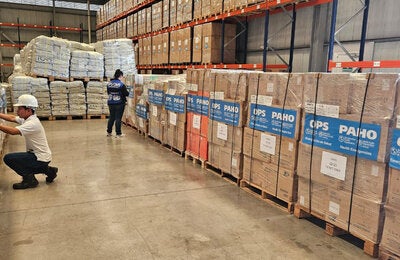Washington, Oct. 21, 2010, (PAHO/WHO) — The Pan American Health Organization said today that it has received laboratory confirmation of cases of cholera in Haiti, in Artibonite province, and is responding to help the Ministry of Health assess the situation and respond appropriately to save lives. So far, PAHO has been informed that more than 1,500 cases of severe diarrhea and at least 138 deaths have been reported in St. Marc, Grande Saline, and Mirebalais.
PAHO has mobilized epidemiologists and other experts from its office in Port-au-Prince and from other countries to help local and national authorities assess and deal with the event, which marks the first time cholera has appeared on the island of Hispaniola, shared by Haiti and the Dominican Republic.
The organization is collaborating with partners including the US Centers for Disease Control, US Agency for International Development, OCHA, Medecins Sans Frontieres, and other non-government organizations to combat the outbreak.
Cholera is an disease caused by ingestion of food or water contaminated with the bacterium Vibrio cholerae. An acute intestinal infection, it causes severe watery diarrhea and vomiting, and can quickly lead to severe dehydration and death. Most cases can be treated with oral rehydration salts, though more severe cases need hospitalization with intravenous fluids and appropriate antibiotics. The goal of treatment is to keep up with fluid loss caused by diarrhea and vomiting.
"With good case management, we can prevent people from dying, perhaps only <1% of cases. However, in areas where there is no good way of ensuring patients remain adequately hydrated, death rate or case fatality ratio may rise substantially, closer to 50%. Ultimately, we want to prevent cases by implementing sound water and sanitation measures, then when cases occur, prevent them from succumbing to severe dehydration," said Dr. Jon Andrus, Deputy Director of PAHO.
"The challenge for Haiti will be to ensure all severe infections are adequately cared for. One of the benefits of the response to the earthquake is that most people feel that citizens have better access to health services. This access will need to be further enhanced in the initial phases of this outbreak. It is likely that outbreak will continue to spread, but with adequate provision of services, mortality can be maintained at very low levels. Community mobilization and education on washing hands and safe water will be critical to stopping transmission. The strong partnership that exists should go a long way toward achieving that end," Dr. Andrus said.
On January 12, 2010, a powerful 7.0 earthquake devastated Haiti, causing massive loss of life, catastrophic building damage, and unimaginable human suffering. The Government of Haiti estimates 220,000 people lost their lives and over 300,000 people were injured. The earthquake crippled Haiti's infrastructure, and eight hospitals were destroyed and 22 seriously damaged in the three regions most affected. In the weeks and months after the earthquake, more than 1.5 million internally displaced Haitians settled in temporary sites throughout Port-au-Prince and beyond. Health Cluster partners collaborated on projects addressing acute health needs and pervasive threats associated with crowded and unhygienic living conditions. The Centers for Disease Control, the Ministry of Health, and PAHO/WHO established a system of disease surveillance using fixed health facilities and mobile clinics, which helped pick up these cases.
Cholera transmission is closely linked to inadequate environmental management. Typical at-risk areas include urban slums, where basic infrastructure is not available, as well as camps for internally displaced people or refugees, where minimum requirements of clean water and sanitation are lacking.
The consequences of a disaster such as the Haiti earthquake, including disruption of water and sanitation systems, or the displacement of populations to inadequate and overcrowded camps — can increase the risk of cholera transmission should the bacteria be present or introduced. Epidemics have never arisen from dead bodies.
Worldwide, there are an estimated 3—5 million cases and 100,000—120,000 deaths due to cholera every year. Provision of safe water and sanitation is critical in reducing the impact of cholera and other waterborne diseases.
During the 19th century, cholera spread across the world from its original reservoir in the Ganges delta in India. Six subsequent pandemics killed millions of people across all continents. The current (seventh) pandemic started in South Asia in 1961, and reached the Americas in 1991, spreading rapidly from Peru to 20 other countries. At its peak in 1991, the pandemic in the Americas affected some 396,000 people. In 1992 358,000 cases were reported, in 1993 it dropped to 211,000, and cases began to decline as a result of strong public health awareness and hygiene measures. Cases have not been widely reported in the Americas since 2001.
Cholera remains a global threat and is one of the key indicators of social development. While the disease no longer poses a threat to countries with minimum standards of hygiene, it remains a challenge to countries where access to safe drinking water and adequate sanitation cannot be guaranteed. Almost every developing country faces cholera outbreaks or the threat of a cholera epidemic.



